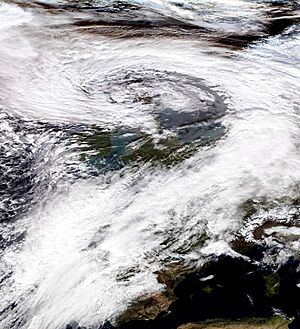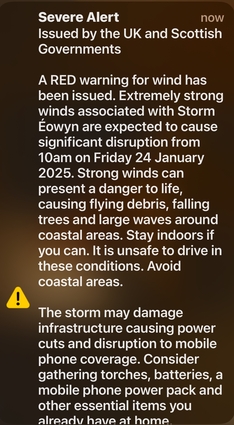Storm Éowyn facts for kids

Éowyn as seen on the 24th of January, 2025.
|
|
| Meteorological history | |
|---|---|
| Formed | 21 January 2025 |
| Dissipated | 27 January 2025 |
| Extratropical cyclone | |
| Highest winds | 156 km/h (97 mph) in Great Dun Fell, a mountain in England. 135 km/h (84 mph) at Mace Head, a coastal weather station in Ireland. |
| Highest gust | 217 km/h (135 mph) at Cairnwell, a mountain in Scotland near Braemar. 114 mph (183 km/h) at Mace Head. |
| Lowest pressure | 941.9 hPa (mbar); 27.81 inHg on Tiree, Scotland |
| Overall effects | |
| Fatalities | 3 |
| Injuries | 5+ |
| Areas affected | Ireland, Isle of Man, Scotland, England, Wales and Norway |
| Power outages | 1,114,340+ 768,000 in Ireland 240,000 in Northern Ireland 340 in Isle of Man 106,000 in Scotland Thousands in Wales Thousands in England Unknown in Western Norway |
|
Part of the 2024–25 European windstorm season |
|
Storm Éowyn (pronounced AY-oh-win) was a very strong storm that hit Ireland, the Isle of Man, and the United Kingdom on January 24, 2025. It then moved on to Norway that same night. This storm was the twenty-seventh one in the 2024–25 European windstorm season. It was named by the UK Met Office on January 21, 2025.
Before the storm arrived, serious red weather warnings were put out for Ireland, Scotland, and the Isle of Man. Amber and yellow warnings were also issued for Wales, England, and Norway. Storm Éowyn was the most powerful storm to hit Ireland since Hurricane Debbie in 1961. It even broke an 80-year-old wind speed record for the country.
Contents
Storm's Name: Éowyn
On January 21, 2025, the UK Met Office and other weather groups in Europe decided to name the storm "Éowyn." This was the fifth storm of the 2024–2025 season. The name Éowyn comes from a character in J. R. R. Tolkien's famous book, The Lord of the Rings. The name was chosen from a list of suggestions sent in by the public.
How the Storm Formed
This powerful storm was made stronger by a fast-moving jet stream. It also got energy from a blizzard that had happened a few days earlier, which brought a lot of snow to the Gulf Coast of the United States.
Warnings and Getting Ready
Ireland's Preparations
On January 22, 2025, Ireland's weather service, Met Éireann, issued an orange wind warning for all 26 counties of the Republic of Ireland. This warning was for strong winds from 2 AM to 5 PM on January 24. They also issued a more serious red wind warning for counties Clare, Cork, Kerry, and Limerick, from 3 AM to 10 AM on January 24. Met Éireann expected wind gusts of up to 130 km/h (81 mph) in many places, with even stronger gusts in some areas.
On January 23, Met Éireann and the UK Met Office updated their red weather warnings to cover all counties on the island of Ireland for January 24. They warned about trees falling, damage to power lines, power outages, and damage to buildings. They also expected travel to be disrupted and cancelled, with large waves hitting coastal areas, especially in the west.
To keep everyone safe, all schools, preschools, colleges, and universities were told to close for the entire day. Many non-essential services stopped, and some supermarkets either closed all day or opened later after the red alert was lifted.
Special planes called Hurricane Hunter aircraft from the U.S. National Oceanic and Atmospheric Administration (NOAA) were sent to Shannon Airport on January 22. Their job was to study Storm Éowyn as it got closer. This was the first time these planes had been sent to Europe since Hurricane Ophelia in 2017.
Isle of Man's Preparations
On January 23, 2025, the Met Office issued a red warning for the Isle of Man. This was the first red warning there in seven years. Life-threatening winds of up to 85 mph (137 km/h) were expected on January 24, between 7 AM and 2 PM. The last red warning for wind was during Storm Eleanor in 2018. People were told to stay indoors because flying debris was extremely dangerous.
All schools, buses, and the A18 Mountain Road were closed by 5 AM. Ferry services and flights were cancelled, and the airport stayed shut until 4 PM.
United Kingdom's Preparations
The Met Office predicted that Storm Éowyn would bring very strong winds across much of the UK. Gusts could reach up to 75 mph (121 km/h) inland and 80 mph (130 km/h) in coastal areas, especially in Northern Ireland, northern England, northwestern Wales, and southern central Scotland. Heavy rain was also expected, which could cause problems. Some snow was predicted in northern areas at first, changing to rain as warmer air moved in.
Yellow wind warnings were in place for many parts of the UK for 24 hours on January 24, 2025. These included areas like the East Midlands, London, and Wales. On January 22, the Met Office issued an amber wind warning for north Wales, northern England, southern Scotland, and Northern Ireland. Winds in these areas were expected to be 60–70 mph (97–113 km/h) inland, and possibly over 90 mph (140 km/h) in exposed coastal and hilly places.
A rare red warning for extremely damaging winds was issued for Northern Ireland and Southern Central Scotland. Winds in this red warning zone were expected to reach 75–80 mph (121–129 km/h) inland (even higher in Glasgow, around 80–85 mph (129–137 km/h)) and 85–95 mph (137–153 km/h), possibly 100 mph (160 km/h) on coasts. Winds were expected to slowly calm down later on January 24.
On January 23, 2025, a 'red' emergency alert was sent to mobile phones across Northern Ireland and parts of Scotland. This alert was sent to about 4.5 million devices, making it the largest use of the UK's emergency alert system since it started in April 2023.
Scotland's Preparations

Before the storm, Transport Scotland warned that travel would be severely disrupted. Police Scotland advised people not to travel in areas with a Red alert. The 'Transport Scotland Resilience Room' was activated to watch the transport network and give updates.
On January 23, 2025, the Scottish Government activated its Scottish Government Resilience Room (SGoRR) to prepare for the storm. First Minister, John Swinney, told the public that the "Met Office has, this morning, issued a very rare red weather warning for Storm Éowyn tomorrow. Their advice is clear that potential impacts include danger to life, structural damage to property, and transport and power disruptions." Swinney said the government was ready to help and coordinate with police, fire, and ambulance services. Chief Superintendent, Hilary Sloan, from Police Scotland Road Policing, also advised people not to travel because conditions would be very dangerous.
Norway's Preparations
On January 23, 2025, MET Norway issued a yellow warning for Western Norway because of Storm Éowyn. This warning was in effect during the night of January 24 into January 25.
Storm's Impact
Ireland's Impact

On January 24, around 5 AM, a wind gust of 183 km/h (114 mph) was recorded at Mace Head Atmospheric Research Station in Connemara, County Galway. The highest official wind gust in Ireland from the storm was 114 mph (183 km/h). This broke an 80-year-old record for the country.
Many flights at Ireland West Airport, Dublin Airport, and Shannon Airport were cancelled or delayed. Ferry services also stopped.
By 9 AM, 815,000 homes, farms, and businesses in Ireland had no power. By lunchtime, nearly one million people on the island of Ireland were without electricity. This was the country's worst storm since Hurricane Debbie in 1961. The Electricity Supply Board reported huge damage to the electricity system. By January 25, 217,000 households had no water because water treatment plants were affected by power cuts.
The storm also caused many trees to fall, blocking roads. Sadly, a 20-year-old man in County Donegal died when a tree fell on his car.
By February 2, 2025, 10 days after the storm, power had been restored to 729,000 customers, but about 39,000 were still without electricity. Engineers from other countries like Austria, Finland, France, Great Britain, Germany, Netherlands, and Norway came to help with repairs.
On February 5, during a discussion in the Dáil (Irish Parliament), it was mentioned that a person's father died because his medical devices stopped working due to power outages. The government said it had given €727,792 in payments to those affected.
By February 9, about 700 electricity customers were still without power. ESB Networks aimed to reconnect most homes by that evening. The remaining outages were mainly in counties Roscommon, Mayo, north Galway, and south Leitrim. Study hubs were set up for students who needed internet access for their exams.
On February 12, ESB Networks announced that power had been restored to all 768,000 customers affected by Storm Éowyn. Over €1.2 million was given out to affected people through a special assistance scheme.
In April 2025, it was reported that 20 to 30 houses in Mayo still did not have a telephone landline connection, more than 70 days after the storm. Also, an estimated 24,000 hectares of forest were blown down by the storm.
Scotland's Impact

Storm Éowyn hit Scotland on January 24, 2025. About 117,000 homes lost power. Wind speeds reached 102 mph (164 km/h) on the Tay Road Bridge. First Minister Swinney asked people to be very careful and urged large trucks not to travel. All ScotRail train services were stopped until the next day. Glasgow Airport and Edinburgh Airport limited their flights, causing cancellations.
Sadly, two people were injured in storm-related accidents in Scotland. One of them, a 19-year-old from East Ayrshire, later died. An SPFL football game was postponed because of damage to Celtic Park.
After the storm passed, the Scottish Government Resilience Room met again on January 25 to help with recovery efforts. Swinney asked the public for "patience" as the cleanup began. By the evening of January 26, about 265,000 people had their electricity back. Road, ferry, and aviation services were almost back to normal. However, about 16,000 people in Scotland were still without power.
Isle of Man's Impact
All travel to and from the Isle of Man was stopped, including ferries and bus services. The Isle of Man Airport, the Snaefell mountain road, schools, and government offices were closed. About 370 homes lost power. The Isle of Man Government declared a major incident because main roads were blocked, cutting off many parts of the island. The island's airport recorded the highest wind gusts in 20 years.
England's Impact
On January 23, one person was injured at Holywell Bay, near Newquay, where "caravans were blowing." This was later confirmed to be a tornado. Thousands of homes in County Durham also lost power, and several roads were closed.
Northern Ireland's Impact
By 11:30 AM on January 24, over 240,000 homes and businesses in Northern Ireland were without power. By February 2, 2025, 10 days after the storm, about 1,600 customers were still without power. Storm Éowyn caused outages for 285,000 customers in total.
Wales's Impact
Places affected in Wales included Ysbyty Gwynedd hospital in Bangor and communities like Bethesda and Menai Bridge. There were widespread power cuts across Wales.
Norway's Impact
The storm's leftover energy hit Norway on January 24 and 25, causing power outages there too.
See also
- Beaufort scale
- Burns' Day Storm of 1990
- Boxing Day Storm of 1998
- Great Storm of 1987
- Hurricane Ophelia (2017)
- Night of the Big Wind
- Storm Eunice


